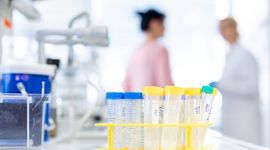Therapy requirements
What would an effective EB therapy look like?
EB is a rare condition, but presents opportunities for therapeutic developments targeting wound repair or the chronic inflammation which predisposes the skin to aggressive cancer. Other approaches use small molecule drugs to modify the skin microenvironment and the course of the disease.
The nature and severity of symptoms and the prognoses, vary widely across the main EB types and subtypes, depending on the affected skin protein. Mutations in one of the 16 classified EB genes are the cause of production of a faulty protein or its complete absence. The important cells for therapy development are the keratinocytes in the epidermis and/or the fibroblasts in the dermis, since these cells produce the proteins that hold the layers of skin together. The skin cells can be manipulated either directly in the body (in vivo), or outside of the body (ex vivo).
Thus, considering the underlying causes, EB therapies must either:
- Replace, inactivate, or repair the affected gene in the cells: Gene Therapies and Combined Gene/Cell Therapies
- Deliver intact, living cells carrying the correct gene or deliver extracellular vesicle containing genetic information or other bioactive components: Cell therapies and Extracellular vesicle-based (EV) therapies
- Development of nonadherent and biological wound dressings, containing cells, collagens or amonitic membranes: Non-specific Wound healing / Wound dressings
- Modulate the mRNA (gene transcript) to restore protein expression: RNA-based therapy
- Deliver a correct protein: Protein therapy
- Deliver drugs to reduce production of, or reduce the impact of the faulty protein, or increase the production of compensatory proteins: Drug therapy



